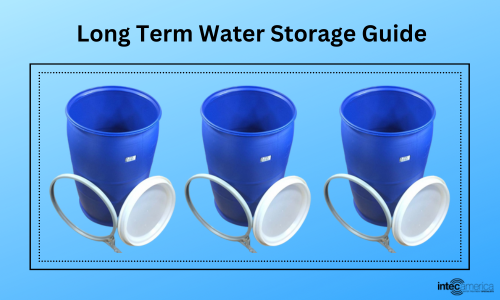Water is a crucial resource without which life won’t exist. Hence, considering the limited availability of water it is crucial to store it, especially during emergencies or unexpected disruptions. Having a clean, safe, and reliable supply of stored water saves many lives and reduces the need to rely on external sources during critical times. Natural disasters such as earthquakes, floods, or hurricanes are sudden and can disrupt the entire infrastructure, including the water supply, leaving people without access to clean water for days, weeks, or even months. In such scenarios, opting for an emergency preparedness water storage solution acts as a lifeline, ensuring the daily needs in terms of drinking, consumption for chores, and sanitation are fulfilled. Now, you may wonder how to install and maintain Long Term Water Storage System. This post highlights the same.

Essential Guidelines for Emergency Water Storage Systems
When it comes to long term or emergency water storage systems, following proper guidelines may be helpful to ensure the water remains clean, safe, and drinkable for long durations. The following are some essential guidelines to consider.
Selecting the Long term Water Storage Container Type or Material
The first vital pointer to consider is to select the container type or material. Choose an FDA-approved plastic or stainless steel container designed for storing water or food. Also, ensure it is made of BPA-free plastic, glass, or stainless steel. Make sure it is covered and can be sealed to prevent contamination and evaporation.
Next, check the storage capacity of the water container. Water storage systems must store adequate water, for instance, 3.8 liters per person per day. So, considering the total number of persons in an area, the tank capacity must be decided.
Long term Water Storage Location
The storage location of the water system also has a significant impact. Store these containers away from the sunlight in a cool place. Also, keep them away from harmful chemicals, pesticides, and strong-smelling substances.
Selecting and Testing Water Sources for Long term Storage
It is also essential to consider the source of water. Make sure to fill the treated water in the emergency storage system. If you rely on well water, get it tested regularly.
Tank water may develop a flat taste when stored for a long time. Changing, recycling, and refilling the stored water every few months is essential to ensure its freshness. The older stored water can be used for non-drinking purposes, such as watering plants, cleaning, etc. Additionally, you can apply labels on the containers indicating the storage date. This will help you keep track of the rotation cycle.
Monitoring and Maintenance of Stored Water Quality
Lastly, perform periodic inspections of the stored water for any sign of cloudiness, discoloration, contamination, etc. If you notice any change, immediately discard the water, and clean the container thoroughly.
Know more about Emergency Water Storage Systems here.
Discussing Long Term Water Storage Prepper Pointers
Today, different long-term water storage treatments are used to ensure the cleanliness and quality of the stored water. They aim to prevent the growth of microorganisms and maintain the potability of water. The following are some important long term water storage treatments.
Boiling
It is one of the most basic, common, yet effective methods to prevent and kill harmful contaminants. Boil the water for three minutes at higher altitudes to ensure disinfection. In tropical and warm regions, water becomes potable when boiled for 20 minutes.
Water Filters
They can effectively remove parasites, bacteria, and other harmful contaminants. Use water filters with a pore size of 0.2 microns or smaller, as they can remove microorganisms effectively.
Distillation
This is effective for removing heavy metals and harmful chemicals. This process involves boiling water, capturing the steam, and condensing it to get purified water.
UV Treatment
Ultraviolet purifiers use UV light to kill bacteria, microorganisms, viruses, and other contaminants present in the water. This treatment effectively treats small to medium quantities of water at a time.
Chemical Disinfection
This process uses chemicals, such as iodine or chlorine bleach, to disinfect stored water. However, following the manufacturer’s specific guidelines and measurements is important. For instance, household bleach contains 5-6% sodium hypochlorite. About 7 to 8 drops can be added per gallon to the stored water and left for 30 minutes before use. Iodine tablets are also a popular disinfectant.
Copper Ionization
This treatment is safer and more effective than chlorination or basic filtration. Installing copper ionizers is easy as you only need to install a copper electrode. Also, it proves cost-effective in the long run. Depending upon the type and capacity of the ionizer, you can purify up to 50,000 gallons of water.
The above guidelines and treatments for emergency water storage systems may be helpful in many situations. Following these techniques and employing effective treatment can ensure safe and reliable water during emergencies. Beyond this, it is always good to consult a reliable leader from this industry if you need any water treatment or storage solution. Intec America stands tall among its competitors. With years of experience and expertise in devising water treatment, storage, emergency preparedness, and more, the company offers reliable, safe, and performance-driven solutions in this segment.
Recent Blog Posts
- Arsenic Water Contamination: Symptoms, Testing, and Treatment
- How To Remove Hard Water Stains
- Pool Chemicals and Their Potential Side Effects
- Thinking About Getting A Mineral Pool: What You Need To Know
- How To Read A Water Quality Report?
- Cloudy Pool Water Causes and Solutions
- Guide to Eradicate Legionella and Other Water-Borne Bacteria from Your Pool
- Everything You Need to Know About Distilled Water
- Well Water Contamination: Causes, Symptoms and Treatment
- Guide to make rainwater potable
- Know Everything About Rainwater Harvesting
- Microplastics in Drinking Water: Causes and Prevention Overview
- Mercury in Drinking Water – Causes, Effects, and Prevention Explained


